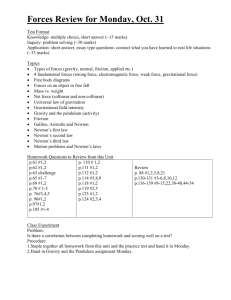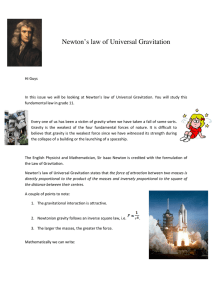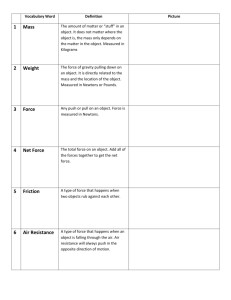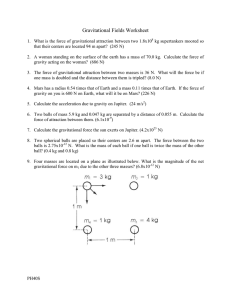Lesson 29: Newton`s Law of Universal Gravitation
advertisement
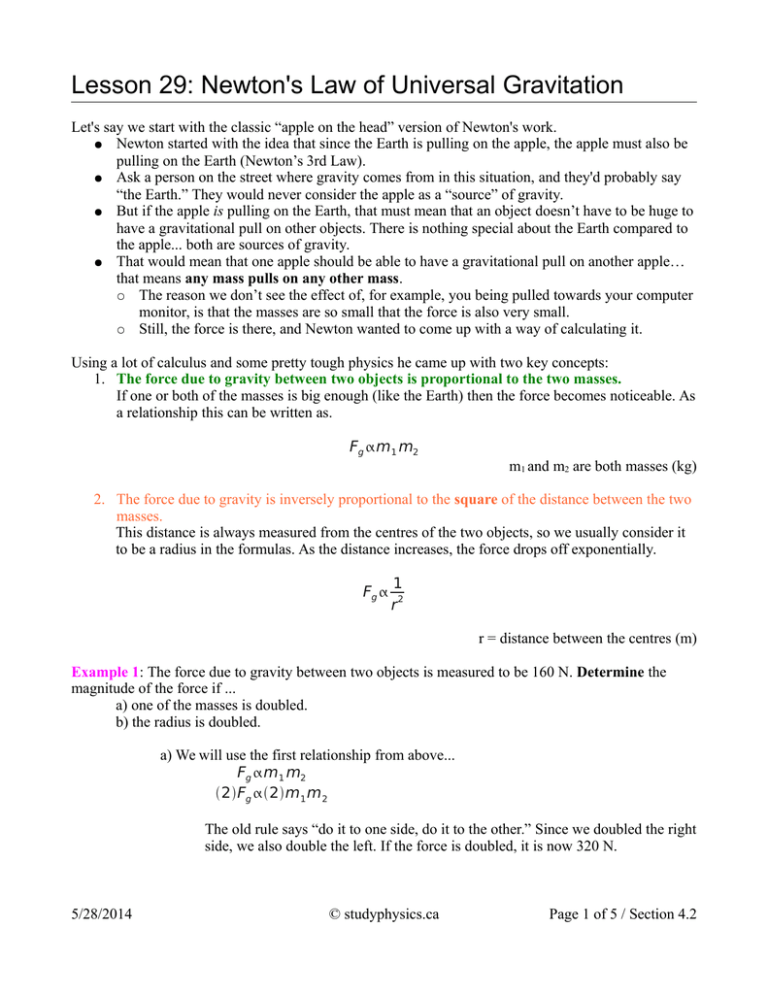
Lesson 29: Newton's Law of Universal Gravitation Let's say we start with the classic “apple on the head” version of Newton's work. ● Newton started with the idea that since the Earth is pulling on the apple, the apple must also be pulling on the Earth (Newton’s 3rd Law). ● Ask a person on the street where gravity comes from in this situation, and they'd probably say “the Earth.” They would never consider the apple as a “source” of gravity. ● But if the apple is pulling on the Earth, that must mean that an object doesn’t have to be huge to have a gravitational pull on other objects. There is nothing special about the Earth compared to the apple... both are sources of gravity. ● That would mean that one apple should be able to have a gravitational pull on another apple… that means any mass pulls on any other mass. ○ The reason we don’t see the effect of, for example, you being pulled towards your computer monitor, is that the masses are so small that the force is also very small. ○ Still, the force is there, and Newton wanted to come up with a way of calculating it. Using a lot of calculus and some pretty tough physics he came up with two key concepts: 1. The force due to gravity between two objects is proportional to the two masses. If one or both of the masses is big enough (like the Earth) then the force becomes noticeable. As a relationship this can be written as. Fg m1 m2 m1 and m2 are both masses (kg) 2. The force due to gravity is inversely proportional to the square of the distance between the two masses. This distance is always measured from the centres of the two objects, so we usually consider it to be a radius in the formulas. As the distance increases, the force drops off exponentially. Fg 1 r2 r = distance between the centres (m) Example 1: The force due to gravity between two objects is measured to be 160 N. Determine the magnitude of the force if ... a) one of the masses is doubled. b) the radius is doubled. a) We will use the first relationship from above... Fg m 1 m2 2Fg 2m1 m 2 The old rule says “do it to one side, do it to the other.” Since we doubled the right side, we also double the left. If the force is doubled, it is now 320 N. 5/28/2014 © studyphysics.ca Page 1 of 5 / Section 4.2 b) We use the second relationship this time... 1 Fg 2 r Fg 1 4 2r2 Notice how we doubled the radius, which is squared and on the bottom. So, on the other side we are dividing the force by four. That gives us an answer of 40 N We can take the two relationships and put them together to make a formula. G m1 m 2 Fg= 2 r Warning! The gravitational constant “G” is not the same as the acceleration due to gravity “g.” Fg = force due to gravity between the two objects (N) G = the Gravitational Constant m1 and m2 = the two masses (kg) r = the distance between the two objects’ centres (m) Did You Know? This is the first formula that you'll see from a family of formulas called the "inverse square formulas". They all look pretty much the same, and lead physicists to believe that there are many common connections and relationships throughout all of physics. Newton turned his attention to trying to find the value for the Gravitational Constant, “G”. ● Newton looked for a way of calculating the value for G from the formula above. If we solve that formula for G we get... Fg r 2 G= m 1 m2 ● Let’s look at how we will substitute numbers into this formula. ● Newton realized that the only thing he could measure Fg for would be an object on Earth’s surface. An example would be you. We could calculate the force due to gravity on your body easily using Fg = mg. ● We need to know the distance from the centre of the Earth to your centre, which we do have: 6.38e6 m. And yup, they even had a pretty good estimate of this in Newton's time! ● We need to know your mass, which would be m1… that’s no problem. ● The last thing we need, m2, is the mass of the Earth. Oh, oh. That one is a problem. ○ In Newton’s time no one had any idea how heavy the Earth really was. ○ If we knew G, then we could calculate the mass of the Earth, but that’s what we are trying to calculate here! ● Newton continued to look for some way to calculate G indirectly, but never found a way. 5/28/2014 © studyphysics.ca Page 2 of 5 / Section 4.2 Henry Cavendish About a 100 years later, a man named Henry Cavendish finally figured out a way to measure the value for the Universal Gravitational Constant “G.” ● He attached a really heavy pair of metal spheres to the ends of a long metal rod, and then hung the rod from a wire. ● He then brought another pair of really heavy metal spheres near the spheres on the rod. ● Cavendish knew that because they had mass they should pull on each other, but very weakly. ● To measure this weak pull, he carefully measured how much Illustration 1: Cavendish's Torsion the wire was twisting (torque) whenever he brought the Balance. other masses near by. ● This is why the device he used is called a torsion balance. After a lot of very careful, very tedious tries, he found that G was 6.67e-11 Nm2/kg2. ● Cavendish realized that because he knew the value for G, he could now calculate the mass of the Earth. That’s why he titled the paper that he published “Weighing the Earth.” Example 2: Using values that you know, determine the mass of the Earth. ● No cheating! Don't look up the value for the mass of the Earth on your data sheet; you're supposed to calculate it. ● We know that the force exerted on my body by the Earth is my weight, which we can calculate using Fg = mg , where little “m” is my mass (we think of it as being like a little test mass). ● I also know that the force could be found using Newton's big Universal Gravitation Formula, where one mass is a little “m” (my “test” mass), and the other mass is a big “Me” (the mass of the Earth). ● Let's make those two formulas equal to each other (they're both force due to gravity after all) and see what happens. Fg =Fg G mtest Me cancel the little test mtest g= r2 mass G Me g= 2 r 2 gr M e= G 9.816.37e62 M e= 6.67e-11 Me=5.99e24kg ● This is pretty close to the accepted value on your data sheet. 5/28/2014 © studyphysics.ca Page 3 of 5 / Section 4.2 Example 3: You have a 200g pickle next to a 345g sandwich on your plate. Their centres are 4.5cm apart. Determine the force of gravity of the pickle pulling on the sandwich. Keep in mind that according to Newton's Third Law, as much as the pickle pulls on the sandwich, the sandwich pulls on the pickle just as hard. The value that we are going to calculate could be used for either situation. Also, don't forget to convert the masses to kilograms, and the distance to metres. G m1 m2 Fg= r2 6.67e-11( 0.200)(0.345) F g= 0.0452 F g=2.272741e-9=2.3e-9 N Example 4: Io is one of Jupiter's moons. It is known to have 400 active volcanoes. One of the reasons it is so active is because of the gravitational pull of Jupiter on Io. On one particular occasion the Sun, Io, and Jupiter lined up in a straight line so that both the Sun and Jupiter were pulling Io in opposite directions. Using the information given on the chart, determine the net force acting on Io at this time. Celestial Distance from Io Mass (kg) Body (m) Io n/a 8.93e22 Jupiter 4.22e8 1.90e27 Sun 7.98e11 1.99e30 Illustration 2: Jupiter's moon Io. The arrangement of the three bodies would look something like this... FS Sun FJ Io Jupiter Illustration 3: Arrangement of bodies. While Jupiter is pulling Io to the right (positive direction), the Sun is pulling Io to the left (negative direction). Calculate each force separately and then add them. F J= G m1 m2 2 r 6.67e-118.93e221.90e27 F J= 4.22e82 F J=6.35486e22 N 5/28/2014 FS= Gm1 m2 2 r 6.67e-118.93e221.99e30 FS= 7.98e112 FS=1.861335e19N © studyphysics.ca Page 4 of 5 / Section 4.2 FNET =F JF S FNET =6.35486e22−1.861335e19 FNET =6.35299e22=6.35e22N Notice how the effect of the Sun is unimportant in this situation. This is because it is so far away from Io compared to Jupiter. It would be the same as asking you which is a more important force acting on your body, the pull of the Earth or the pull of the Sun? Although the Sun is a much bigger mass, it is also very far away, so the effect of its pull on your body isn't noticeable. Homework p207 #2 p208 #1 p209 #2 5/28/2014 © studyphysics.ca Page 5 of 5 / Section 4.2
